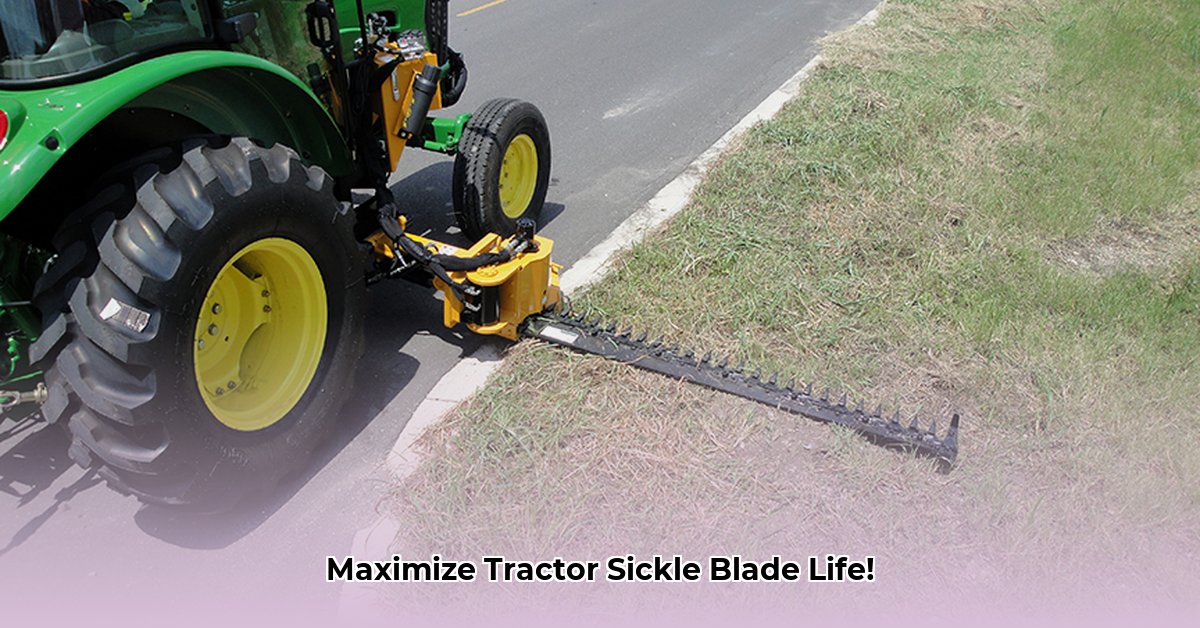
Sickle Blade for Tractor: Making Your Farm More Eco-Friendly
Sustainable farming practices are paramount for a healthy planet. A crucial, yet often overlooked, aspect is the sustainability of farm equipment, particularly the sickle blades integral to harvesting. This guide focuses on extending the lifespan of tractor sickle blades, thereby reducing waste and promoting environmentally responsible agriculture. We’ll examine the factors influencing their sustainability, explore the challenges in assessing their environmental impact, and provide actionable steps for small-scale farmers, manufacturers like Tractor Supply Company (TSC), and policymakers. The current lack of readily available data on the environmental effects of sickle blades throughout their lifecycle presents a significant hurdle, hindering a comprehensive assessment of their true eco-friendliness. For more on small tractor attachments, see this helpful resource.
Factors that Determine How Green Your Sickle Blades Are
Several intertwined factors determine the environmental impact of your tractor's sickle blades:
Material Sourcing: The raw materials used and their sourcing methods significantly impact the environmental footprint. Were they sustainably harvested? Were energy-efficient manufacturing processes employed? Lowering the embodied carbon (the total greenhouse gas emissions from the creation to disposal of the product) is key.
Durability and Longevity: A durable, long-lasting blade minimizes replacements, reducing resource consumption and waste. Research into blade design focusing on minimizing wear and tear is crucial for maximizing lifespan. How can we objectively measure and compare the longevity of different blades?
End-of-Life Management: Responsible disposal is crucial. Can the blade be recycled or reused? Manufacturers are exploring blade refurbishment or recycling programs to reduce waste, but standardized protocols are needed. What percentage of sickle blades are currently recycled?
Maintenance Practices: Proper maintenance dramatically extends blade lifespan. Using eco-friendly lubricants and regular sharpening are examples of sustainable maintenance. How much can proper maintenance extend the average lifespan of a sickle blade?
Sustainable Farming Practices: Even the most sustainable blades cannot offset unsustainable farming methods. Sustainable soil management techniques are essential complements to sustainable equipment use. What percentage of farmers integrate sustainable soil management practices with their equipment maintenance?
The Challenge of Measuring Sickle Section Sustainability
Accurately assessing the environmental impact of sickle sections is complex due to a lack of readily available data. Comprehensive lifecycle assessments (LCAs) are currently hindered by the absence of detailed information on materials, manufacturing processes, and end-of-life management. This scarcity limits our understanding of their overall environmental footprint. This data gap highlights the critical need for increased transparency from manufacturers and further research to develop standardized assessment methods.
Taking Action for a More Sustainable Future
Several actionable steps can be taken by various stakeholders:
Actionable Steps for Tractor Supply Company (TSC) and Other Manufacturers:
- Transparency: Conduct and publicly share comprehensive LCAs for all sickle blade models. This detailed analysis should cover the entire lifecycle, from raw material sourcing to disposal.
- Sustainable Sourcing: Prioritize responsibly sourced raw materials, using certifications and transparent disclosure of sourcing practices. Explore using recycled materials and local sourcing to minimize transportation emissions.
- Recycling Programs: Develop robust closed-loop recycling programs for worn-out blades, diverting them from landfills.
Actionable Steps for Small-Scale Farmers:
- Demand Transparency: Seek out products with clear sustainability labels and support companies committed to transparency.
- Prioritize Durability: Invest in high-quality, durable blades, which, although potentially more expensive initially, offer long-term cost savings by reducing replacement frequency.
- Proper Maintenance: Invest in training on proper maintenance techniques, including regular sharpening, cleaning, and lubrication.
Actionable Steps for Policymakers:
- Incentivize Sustainability: Implement policies promoting sustainable agricultural practices and data transparency from manufacturers, such as subsidies or tax breaks for using sustainable materials.
- Support Eco-Friendly Tech: Offer financial incentives for the development and adoption of environmentally friendly agricultural technologies.
- Extended Producer Responsibility (EPR): Implement EPR schemes to hold manufacturers accountable for end-of-life management of their products.
Actionable Steps for Researchers and NGOs:
- Comparative Research: Conduct rigorous comparative studies of various agricultural tools and materials, utilizing standardized testing protocols and LCA analysis.
- Advocacy for Data Transparency: Advocate for standardized product labeling, making it easier to compare the sustainability of different products.
Recommendations and Future Research Needs
The sustainability of sickle sections hinges on increased data transparency and rigorous research. Standardized methodologies for assessing wear and tear are needed, alongside collaborative efforts between manufacturers, researchers, and policymakers to establish clear metrics for evaluating environmental impacts across the entire lifecycle. This collaborative approach is essential for promoting environmentally responsible agriculture and ensuring a sustainable future for farming.